|
|
|
|
| A study of MADAGASCAR GARNET |
|
|
| Garnet Crystal System: cubic. |
|
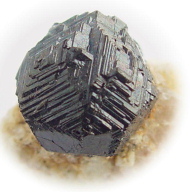 |
|
|
|
|
| Red - violetish: |
Hardness |
Density |
Ref.Index |
| Pyrope Mg3Al2Si3O12 |
7,25 |
3,58 g / cm3 |
1,714 |
| Almandine Fe3Al2Si3O12 |
7,50 |
4,32 |
1,830 |
| Rhodolite Mg,Fe3Al2SiO12 |
7,25 |
3,78 - 3,90 |
1,74 -1,78 |
|
|
|
|
| Orange - yellow-brown : |
|
|
|
| Spessartite Mn3Al2Si3O12 |
7,25 |
4,20 - 4,25 |
1,78 - 1,81 |
| Malaya (Mg,Fe,Mn,Ca)3Al2(SiO4)3 |
7,25 |
3,74 - 4,00 |
1,78 |
| Hessonite Ca3Al2(SiO4)3 |
7,25 |
3,58 - 3,65 |
1,73 - 1,74 |
|
|
|
|
| Green : |
|
|
|
| Tsavolite Ca3Al2(SiO4)3 |
7,25 |
3,60 - 3,68 |
1,73 - 1,74 |
| Uvarovite Ca3Cr2Si3O12 |
7,50 |
3,85 |
1,87 |
| Dementoïde Ca3F2SiO12 |
6,5 - 7 |
3,82 - 3,85 |
1,89 |
| In a perfect crystal, when a face appears in the crystal in the process of growth, all the faces appear with the same |
| development. |
| If one of the symmetrical faces is less developed on a crystalline sample, or exceptionally does not appear, that |
| comes from the accidental actions of the external environment which opposed its growth. |
| Temperature, pressure, nature of the mineral solution, speed of the crystalline growth and the direction of the |
| movement of solution etc... represent the external influences on the crystalline shapes. |
| The frequency of the faces of the crystals is related to the reticular density, the fast growth of some faces |
| influences the crystalline shape definitively. |
| Garnet thus crystallizes under the cubic system, which crystals are characterized by the presence of three |
| quaternary axes A4 joining the centers of the faces, four ternary axes A3 joining the opposed tops, six binary |
| axes A2 joining the mediums of the edges. |
|
| |
| · One of the causes modifying the initial shape of crystals is truncation. |
| Truncation on corners. |
|
|
|
|
|
|
|
|
 |
 |
 |
 |
| Cube |
|
|
Dodecahedron |
|
|
|
|
|
|
| Truncation cuts two different lengths on adjacent corners. |
|
|
 |
 |
 |
| Cube |
|
Tetrahexahedron |
|
|
|
|
| Truncation cutting three equal lengths out of the three adjacent corners. |
|
|
 |
 |
 |
 |
| Cube |
|
|
Octahedron |
|
|
|
|
|
|
|
|
|
|
|
|
|
| Truncation cuts two equal lengths out of two corners and a larger length on the third. |
|
|
|
|
 |
 |
 |
| Trisoctahedron |
|
Octahedron |
|
|
|
|
|
|
|
|
|
|
|
|
|
|
|
|
|
|
|
|
|
|
|
|
| Truncation on the segment crosses, two equal lengths out of two corners, a smaller length on the third. |
|
|
|
|
 |
 |
 |
| Cube |
|
Trapesohedron |
|
|
|
|
|
|
|
|
|
|
|
|
|
|
|
 |
 |
 |
| Octahedron |
|
Trapesohedron |
|
|
|
|
|
|
|
|
|
|
|
|
|
|
|
 |
 |
 |
| Dodecahedron |
|
Trapesohedron |
|
|
|
|
|
|
|
|
|
|
|
|
|
|
|
 |
 |
 |
| Hexoctahedron |
|
Dodecahedron |
|
|
|
|
|
|
|
|
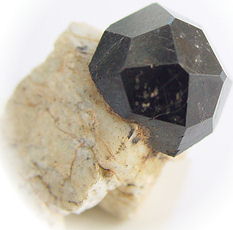 |
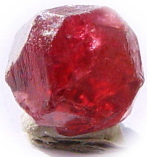 |
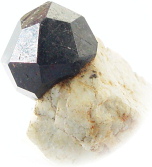 |
| Almandine in matrix |
Pyrope-Almandine |
Almandine in matrix |
|
|
|
|
|
|
|
|
|
|
|
|
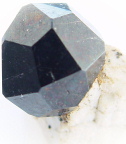 |
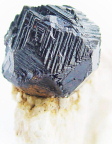 |
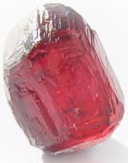 |
| Almandine in matrix |
Almandine in matrix |
Rhodolite (Ambohitompoina) |
|
|
|
|
|
|
|
|
|
|
|
|
|
|
|
|
|
|
|
|
|
|
|
|
| |
| There is also a law according to which certain crystals do not present modifications that on half of corners, or of the |
| similar angles. |
| Here is a truncation on a top cutting three different lengths on corners, and which repeats only three times around |
| the ternary axis. |
 |
 |
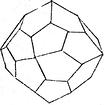 |
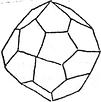 |
| Cube and diplohedron |
Diplohedron |
Right Gyrohedron |
Left Gyrohedron |
|
|
|
|
| The diplohedron is made of twenty-four irregular quadrilaterals. The class plagiohedron which faces (HKL) are |
| arranged in the spiral order. |
| |
|
|
|
|
|
|
| In other cases, twelve irregular pentagons are formed by a truncation on one sharp angle, on both adjacent angles, the |
| unequal lengths, it is the pentagonal dodecahedron. |
|
|
|
 |
 |
 |
 |
|
Positive |
Negative |
|
|
|
|
|
|
| The regular tetrahedron consisted four equilateral triangles forming between them an angle of 70° 31. |
 |
 |
 |
| Positiv tetrahedron |
Négativ tetrahedron |
Octahedron |
|
|
|
 |
 |
 |
| Positiv tetrahedron |
|
Cube |
|
|
|
|
|
|
|
|
|
|
|
|
| The tetrahedron or triakistetrahedron consisted twelve faces which are isosceles triangles, and the hexatetrahedron |
| with its twenty four triangular faces. |
 |
 |
| Triakistetrahedron |
Hexakistetrahedron |
|
|
| |
| The trapezoidal dodecahedron consisted twelve quadrilaterals deltoid and the tetrahedral pentagonal dodecahedron |
| are formed by a truncation appearing on each top and cutting three different lengths on angle. |
| |
|
|
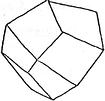 |
 |
 |
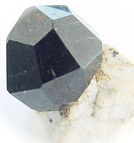 |
| |
right |
left |
|
| Deltoid dodecahedron |
Pentagonal tetraedrical dodecahedron . |
Almandine in matrix |
|
|
|
|
|
|
|
|
|
|
|
|
|
| In Madagascar, one finds rhodolite in a gneiss rich in biotite, in which (almandite-pyrope) is presented in the form of |
| small grains, or in the state of large porphyroblasts, generally deprived of geometrical contours, plagioclase |
| (oligoclase with andesine) is the feldspar dominating and sometimes exclusive. These gneisses contain sometimes |
| pegmatic beds very rich in crystals. |
| One very finds also garnetiferous gneisses containing little biotite, hardly directed. |
| Kinzigites. The gneisses which have been just enumerated have a very clear schisteous structure, which had with the |
| biotite abundance. A rather frequent type is approximately blocks and presents a compact aspect, thanks to the |
| prevalence of large garnets without geometrical form, associated quartz and granoblastic feldspar, biotite is not |
| very abundant. The structure points out that of corneal micaceous of contact of the granite. This gneiss can be |
| compared with the kinzigite of the Black Forest. |
|
| Leptynites with amphibolo-pyroxenite intercalation rich in garnets of a pale pink (almandite-pyrope), with often |
| rutile and graphite abound in certain areas of Madagascar. The feldspar is orthoclase, associated with |
| ogigoclase-albite feldspar and sometimes with spindle-shaped microperthite, there exists much of myrmekite. |
| These rocks are with fine grins, but they very often contain large regularly distributed crystals. |
| Usually garnet does not have a geometrical form, but it takes clear faces in more quartzose zones. |
| Leptynites derive from the granites by disappearance of the mica; the garnetiferous mica schists constitute the |
| opposed pole in which biotite prevails, with progressive disappearance of feldspar. |
|
|
| |
|
|
|
|
|
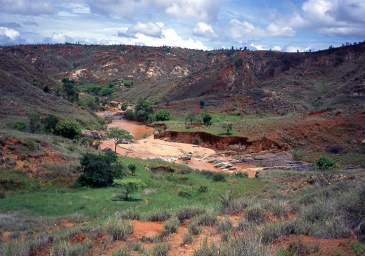 |
|
| The Besafotra river carry out spessartites |
| on several kilometers from their source, |
| doubtless a sodolitic pegmatite. |
| A walk of 25 kilometers among the mountains |
| is necessary to reach this place. |
| |
| |
|
| SPESSARTITE GARNET |
|
|
|
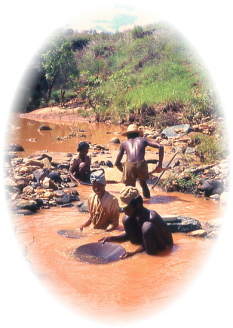 |
|
|
| |
|
| |
|
|
|
|
|
| The tanety "grounds bordering the river," are also |
|
| the object of the orange garnet's fever. |
|
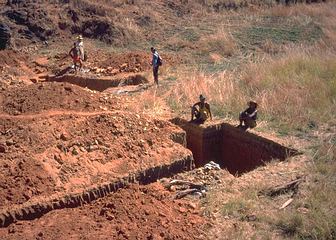 |
|
|
|
|
|
|
|
|
|
|
|
Sifting in river. |
|
Initially, the spessartite appeared in the |
|
Besafotra river, searched out here near to |
|
its source. |
| |
|
|
|
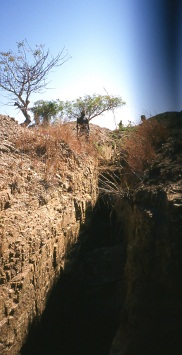 |
|
|
|
Ankilytokana, one of the fabulous rhodolite occurrences |
|
exploited in a leptynite vein on a sixteen meters depth. |
|
|
|
RHODOLITE GARNET |
|
Leptynites are primarily consisted in alkaline feldspars |
|
and quartz. When these rocks are not ribboned, and |
|
that is frequent, it is often difficult to decide if a sample, |
|
not seen in place, belongs to a leptynite or an aplite, it |
|
should be noticed that in Madagascar, these last |
|
contain microcline and not orthoclase. In this area, |
|
one observes graphite spangles in the leptynites. |
|
|
|
|
|
|
|
|
|
|
|
|
|
|
|
|
|
|
|
|
|
|
| |
|
| |
|
| Malaya garnet discovered into |
|
| September 1998, in eluvium in |
|
| a broken up leptynite. |
|
| The modest depth of the deposit did |
|
| not require any significant work to |
|
| extract it. |
|
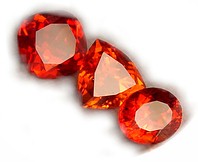 |
|
|
|
|
|
|
|
|
|
|
This stone shows an exceptional capacity to restore |
|
the light, thanks in particular to its high refractive index, |
|
especially under not very enlightened condition. |
|
|
|
| Malaya Garnet Discovery |
| |
 |
|
Your guide to GGGems |
 |
©  All of the pictures on this website have been shot by gggems.com All of the pictures on this website have been shot by gggems.com |
Alain Darbellay |
| Text written by Alain Darbellay. |
|
|